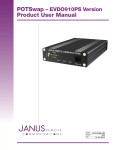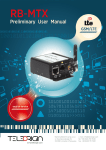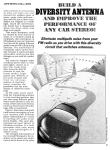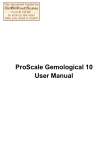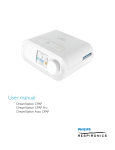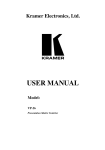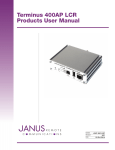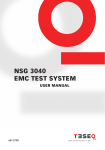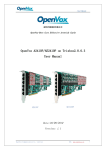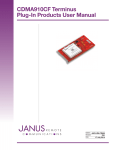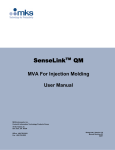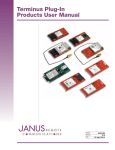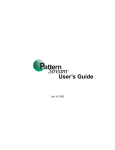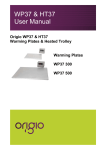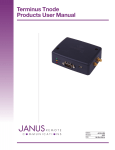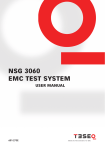Download HSPA910PS User Manual
Transcript
POTSwap – HSPA910PS Version Product User Manual Bulletin Revision Date JA16-GSM-UM P05 08 Sept 2015 TABLE OF CONTENTS TABLE OF CONTENTS, LIST OF FIGURES and DISCLAIMER........................................................................................... 2-3 1. POTSwap General Description .................................................................................................................................. 4 2. Plug-In Terminals......................................................................................................................................................... 4 3. Operation.................................................................................................................................................................. 5-6 3.1 Set-up 3.2 Voice Operation 3.2.1 Placing Calls Manual Telephones Automated Dialers 3.2.2 Receiving Calls 3.2.3 Call Disconnect 3.2.4 Call Unconnected Busy 3.3 Data Operation 4. Configuration.......................................................................................................................................................... 7-10 5. External Interface ................................................................................................................................................ 11-14 5.1 Front Panel: Received Signal Strength Indicator LED Operational indicators: POWER (RED) LED CELLULAR (YELLOW) LED STATUS (GREEN) LED PUSH BUTTONS PHONE – FXS Connector 5.2 Rear Panel: Power connectors Antenna connectors Serial Port 6. SIM Card Installation............................................................................................................................................ 15-16 7. Specifications............................................................................................................................................................ 17 8. Compatible Terminal Block Connectors................................................................................................................... 18 9. Ordering Information................................................................................................................................................. 19 10. Accessories............................................................................................................................................................... 19 11. References................................................................................................................................................................. 19 Revision History......................................................................................................................................................... 20 POTSwap User Guide JA16-UM Page 2 Rev: P05 Date: 09/08/15 © Copyright 2015 Janus Remote Communications Specifications subject to change without notice All Rights Reserved See website for latest revision. Not intended for life support applications. TABLE OF CONTENTS continued List of Figures Figure 1. POTSwap Block Diagram Figure 2. Voice Operation Figure 3. Data Operation – Modem to Server Figure 4. Data Operation – Modem to Modem Figure 5. Serial Connection Figure 6. Front Panel Figure 7. RJ11 Jack Figure 8. Rear Panel Figure 9. Serial Port Figure 10. End Panel Screw Removal Figure 11. Exposed Circuit Board Figure 12. SIM Card Socket Figure 13. Re-Assembled Unit DISCLAIMER The information contained in this document is the proprietary information of Connor-Winfield Corporation and its affiliates (Janus Remote Communication). The contents are confidential and any disclosure to persons other than the officers, employees, agents or subcontractors of the owner or licensee of this document, without the prior written consent of Connor-Winfield, is strictly prohibited. Connor-Winfield makes every effort to ensure the quality of the information it makes available. Notwithstanding the foregoing, Connor-Winfield does not make any warranty as to the information contained herein, and does not accept any liability for any injury, loss or damage of any kind incurred by use of or reliance upon the information. Connor-Winfield disclaims any and all responsibility for the application of the devices characterized in this document, and notes that the application of the device must comply with the safety standards of the applicable country, and where applicable, with the relevant wiring rules. ConnorWinfield reserves the right to make modifications, additions and deletions to this document due to typographical errors, inaccurate information, or improvements to programs and/or equipment at any time and without notice. Such changes will, nevertheless be incorporated into new editions of this application note. All rights reserved 2012 Connor-Winfield Corporation POTSwap User Guide JA16-UM Page 3 Rev: P05 Date: 09/08/15 © Copyright 2015 Janus Remote Communications Specifications subject to change without notice All Rights Reserved See website for latest revision. Not intended for life support applications. 1 POTSwap General Description The POTSwap allows landline telephones and modems to replace their POTS (plain old telephone service) connection with a wireless cellular connection. An internal landline modem allows legacy dial-up modem equipment to connect to remote TCP/IP networks. Fixed location voice applications can connect directly to the PSTN (public switched telephone network). Both dial-in and dial-out data and voice applications are supported. An FXS connection (RJ11 jack) provides complete Central Office emulation including dial tone, ringing and busy signal generation as well as DTMF detection and generation. The POTSwap emulates all the functions of a wired telephone connection, is fully compatible with all common modem standards and can be configured to emulate all international telephone line standards. Wireless connectivity is provided by the Janus line of Plug-In Terminus terminal modems which provide support for all current mobile network technologies with service available from numerous wireless carriers. Configuration of the POTSwap can be achieved via a local serial interface connection. Figure 1 POTSwap Block Diagram 2 Plug-In Terminus Cellular communication for the POTSwap is powered by Plug-In Terminus terminals. Plug-In Terminus offer easy integration and interchangeability of communication protocols between GSM/GPRS, CDMA, UMTS, EVDO and more by combining full M2M functionality with the flexibility of a standard “plug-in” DIP design. These terminals share the same mechanical footprint and offer users the ability to configure their applications for communications via any cellular protocol. The POTSwap provides one platform that supports current cellular technology with the future in mind. POTSwap User Guide JA16-UM Page 4 Rev: P05 Date: 09/08/15 © Copyright 2015 Janus Remote Communications Specifications subject to change without notice All Rights Reserved See website for latest revision. Not intended for life support applications. 3 Operation 3.1 Set-Up: Operating the POTSwap with voice (telephone) or data (modem) equipment can be achieved through the following steps: 1. Gather the required equipment: • POTSwap • Power Supply - This can be hard-wired from a user supplied power source via the terminal block header (See section 8 - Compatible Terminal Block Connectors) or using the optional wall transformer (See section 10 - Accessories). • Cellular antenna - A 5-band (‘penta-band’) GSM cellular antenna is recommended. An optional cellular antenna is available (See section 10 - Accessories). • The HE910PS model of the POTSwap requires an activated SIM card. Installation requires a Torx T10 screwdriver (See section 6 - SIM Card Installation). 2. Install the SIM card. See section 6 - SIM Card Installation. 3. Connect a cellular antenna to the SMA connector labeled ‘CELLULAR’. This can be a local antenna or a remote antenna connected by a coaxial cable. (See section 10 - Accessories section.) 4. Connect power to the unit. Once powered, the unit should show a connection to the cellular carrier within a minute. This will be indicated by a rapidly flashing GREEN ‘STATUS’ LED, a blinking ‘CELLULAR’ LED, and a steady signal strength indication on the Received Signal Strength LED stack. 3.2 Voice Operation Voice operation requires a standard voice telephone device to be connected to the POTSwap. MOBILE NETWORK PSTN CELLULAR TELEPHONE POTSwap TELEPHONE VOICE Figure 2 Voice Operation 3.2.1 Placing calls: When the connected telephone device is taken off hook, the POTSwap will present an audio dial tone signal. Dialing can proceed with up to 30 digits being accepted. If the Dialing Tone Timeout (30 second default) elapses before the first digit is dialed, the dialing session is ended by an Open Switching Interval (900 millisecond default). If the Dialing Digit Timeout (4 second default) elapses after a dialed digit, dialing is concluded and a call to the dialed number is placed. At any time the number sign (‘#’) can be dialed and the call is placed immediatly, avoiding the Dialing Digit Timeout. Note that if Fixed Format Dialing is enabled, the dialed number must consist of a ten digit phone number that includes the area code, or an eleven number when the first digit is a ‘1’. Firmware versions earlier than 150908 only allow dialing fixed format, 10 or 11 digit numbers. Telephone devices that automatically take the phone off-hook and place a call to a fixed telephone number are compatible with the POTSwap. Dialing digits should not be sent faster than 100 ms per digit, with a minimum DTMF tone duration of 45 ms. The POTSwap is compatible with DTMF dialing only. Pulse dialing will not work. POTSwap User Guide JA16-UM Page 5 Rev: P05 Date: 09/08/15 © Copyright 2015 Janus Remote Communications Specifications subject to change without notice All Rights Reserved See website for latest revision. Not intended for life support applications. 3 Operation continued 3.2 Voice Operation continued 3.2.2 Receiving calls: Incoming calls will cause the POTSwap to generate a ringing signal on the phone line. Taking the connected telephone line off-hook will answer the incoming call. Note that cellular carriers typically impose a 30 second limit on unanswered ringing before a call is transferred to a voice mail system. 3.2.3 Call Disconnect: A call can always be terminated by placing the connected telephone equipment on-hook. If a cellular call is terminated on the carrier side (the result of a connected party ending the call or due to loss of signal) the POTSwap will use an Open Switching Interval to aid in disconnecting automated type telephone equipment. It removes the voltage from the phone line connection for a short time to signal that the call has been terminated. The OSI interval can be adjusted using the user configuration menu. 3.2.4 Unconnected Busy: In some instances when dialing a number that is busy, the cellular carriers will not make an audio connection to a busy tone. If this occurs, the POTSwap will generate the busy tone locally for a period defined by the user configurable Busy Dwell Timeout parameter. Following the busy tone, the POTSwap will terminate the call by generating an Open Switching Interval (see section 4 - Configuration). 3.3 Data Operation (Future firmware feature): Telephone modem equipment can be connected to the POTSwap for the purpose of converting a legacy landline data connection to a cellular connection. The POTSwap can simulate the remote dialed modem and transfer the data using a TCP/IP connection. At the remote location, an accommodation has to be made for the change in data transport technology (dial-up modem to internet connection). While this may require modifications to the application software, it may also be possible to support legacy applications with the use of an additional TCP/IP to serial bridge application on the remote host. SERVER MOBILE NETWORK INTERNET CELLULAR DATA MODEM POTSwap PC Figure 3 Data Operation – Modem to Server Alternatively, legacy modem to modem communications can be achieved using a POTSwap at each end of the connection as illustrated below. Note that all data communications requirements will be different, and modifications to the POTSwap firmware may be required to support specific operations. Please contact Janus Remote Communications for details. CELLULAR DATA MODEM POTSwap MOBILE NETWORKS & INTERNET CELLULAR DATA MODEM POTSwap Figure 4 Data Operation – Modem to Modem POTSwap User Guide JA16-UM Page 6 Rev: P05 Date: 09/08/15 © Copyright 2015 Janus Remote Communications Specifications subject to change without notice All Rights Reserved See website for latest revision. Not intended for life support applications. 4. Configuration Configuration of the POTSwap is available via communications with the SERIAL PORT connection. Configuration can be accomplished by connecting a DTE terminal device (e.g. laptop or desktop computer running a terminal emulator) to the SERIAL port using a straight-thru DB9 serial cable (DB9-M to DB9-F). Newer computers may require a USB to serial port adaptor to complete the connection. Figure 5 Serial Connection Default communications protocol is 115200 baud, 8-N-1 (8 data bits, no parity, 1 stop bit) with no handshaking. When the POTSwap is first powered on, it will output something similar to the following: WireLine II Board - POTSwap Audio via digital interface DVI, PCM to SLIC HE910 Power-Up Mode Board has SiLabs Wire Line Modem E911 Voice Calling where system/configuration permit/allow, Installer responsible for validation of service WireLine_Open 7 Speaker Level 4 Microphone Level 1 Echo Cancellation 25 Transport Mode 1 TTY Mode 900 Open Switching Interval 30000 Dialing Tone Timeout 4000 Dialing Digit Timeout 6000 Busy Dwell Timeout 0 Fixed Format Dialing 2 ADC Gain 4 DAC Gain 2 Loop Current Limit 0 Loop Closure Sensing Type 8 Loop Closure Threshold Included in this output are the current configuration settings. Several of these parameters are user configurable and can be adjusted by entering the CONFIG command during the power-up sequence. About 15 seconds following the application of power, the unit offers a short interval wherein the user can enter the terminal configuration menu. The following text will be output: WireLine II Board - POTSwap Entering Terminal Mode, 10 seconds to type first command Type ? for help, Q to exit FW: HH:MM:SS MTH DY YEAR READY At this point the user has 10 seconds to enter one of the following commands followed by a line termination (‘Enter’ key on PC’s): POTSwap User Guide JA16-UM Page 7 Rev: P05 Date: 09/08/15 © Copyright 2015 Janus Remote Communications Specifications subject to change without notice All Rights Reserved See website for latest revision. Not intended for life support applications. 4. Configuration continued TERMINAL MENU COMMANDS COMMAND FUNCTION ?, H Outputs the current menu options. Q, QUIT Exits the menu and causes the POTSwap to proceed with the normal operation. DEBUG xx Factory use only DUMP Adr Len Factory use only XMODEM Download upgrade binary REBOOT Restart Application CONFIG Configure Settings IDENTIFY Display Cellular IMEI (International Mobile station Equipment Identity) and phone number These commands are NOT case sensitive. Terminal menu commands operate as follows: ?, H: Entering a ‘?’ or ‘H’ character will output the Terminal menu command menu again. It can be useful if the menu has scrolled off of a screen. Q ,QUIT: Entering ‘Q’ or ‘QUIT’ will exit the DEBUG menu and continue with the normal start-up and operation of the POTSwap. DEBUG xx: DO NOT USE - Factory use only. DUMP Adr Len: DO NOT USE - Factory use only. XMODEM: Used for firmware upgrades. REBOOT: Entering ‘REBOOT’ will restart the POTSwap, similar to pressing the RESET button. CONFIG: Entering ’CONFIG’ will cause the configuration menu to be output: Janus Remote Communications - WireLine II Board - POTSwap Configuration ======================================================================= Microphone Level [4] 0-7 Speaker Level [7 ] 0-14 Echo Cancellation [1] 0-1 Open Switching Interval [900 ] 0-1200 ms Dialing Tone Timeout [30000] 500-60000 ms Dialing Digit Timeout [4000 ] 250-15000 ms Busy Dwell Timeout [6000 ] 1000-30000 ms Fixed Format Dialing [0] 0-1 GSM Transport Mode GSM TTY Mode [25] 12,22,25 [1] 0-1 SLIC ADC Gain SLIC DAC Gain [2] 0-8 [4] 0-8 Loop Current Limit [2] 0-7 Loop Closure Sense Type [0] 0-1 Loop Closure Threshold [8 ] 0-63 Press M=Modify, D=Defaults, X=Exit and Save, Q=Quit and Discard The configuration menu lists the name of the parameter, the current setting (in brackets), and the range or values of settings available. These settings may vary depending on the model of Plug-In Terminus terminal used in the POTSwap. Following the list of parameters are options for changing the configuration settings or leaving this menu: M, D, X, and Q. These single character command options can be entered in upper or lower case, and no enter key is required. POTSwap User Guide JA16-UM Page 8 Rev: P05 Date: 09/08/15 © Copyright 2015 Janus Remote Communications Specifications subject to change without notice All Rights Reserved See website for latest revision. Not intended for life support applications. 4. Configuration continued CONFIGURATION COMMANDS COMMAND FUNCTION M – MODIFY D – DEFAULTS X – EXIT AND SAVE Q – QUIT AND DISCARD CHANGES Enter the parameter modification menu. Set all parameters to their default (factory) value. Save changes and exit the configuration menu. Discard changes and exit the configuration menu. M – MODIFY Commands: Entering an ‘M‘ command will cause the current setting for each parameter to be output, and allows changing the parameter setting. Currently, the following parameters can be modified: CONFIGURATION PARAMETERS PARAMETER DEFAULT RANGE FUNCTION Microphone Level 4 0-7 Sets the outbound audio gain Speaker Level 7 0-14 Sets the inbound audio gain Echo Cancellation 1 0-1 Enables the Echo Cancellation feature 0 = Echo Cancellation disabled 1 = Echo Cancellation enabled Open Switching Interval 900 0-1200 Sets the period that the battery voltage is removed from the (milliseconds) telephone line following the termination of a call from the carrier side, a dialing timeout, or a locally generated busy tone. (AKA Kewlstart.) Dialing Tone Timeout1 30000 500-60000 Sets time limit for first dialing digit to be entered following going (milliseconds) off-hook. Exceeding the time limit will cause Open Switching Interval to be generated. Dialing Digit Timeout1 6000 250-15000 Sets time limit for time between entering dialing digits. (milliseconds) Exceeding the time limit will cause Open Switching Interval to be generated. Busy Dwell Timeout1 6000 1000-30000 Sets length of time a busy tone is generated locally on calls (milliseconds) where the cellular carrier does not provide an audio connection to a busy tone. The Open Switching Interval will be generated following the busy tone. Fixed Format Dialing4 0 0-1 Enables Fixed Format dialing. When set to ‘1’ (enabled), only 10 digit (or 11 digits when first digit is a ‘1’) dialing and 911 dialing is allowed.When set to ‘0’ (disabled), any number of dialed digits is accepted once the Dialing Digit Timeout is exceeded. Dialing the number sign (‘#’) short-cuts the Dialing Digit Timeout and immediatly accepts the dialed digits. GSM Transport Mode 252 12,22,25 Selects network: 12 = GSM 22 = UTRAN 25 = GSM and UTRAN Use 12 = GSM for best in-band DTMF performance. GSM TTY Mode 1 0-1 TTY MODE enable 0 = TTY mode disabled 1 = TTY mode enabled Improves in-band DTMF transport under certain circumstances SLIC ADC Gain 2 0-8 Sets outbound audio gain during the initial outbound DTMF dialing. Corrects for distortion using some auto dialers. POTSwap User Guide JA16-UM Page 9 Rev: P05 Date: 09/08/15 © Copyright 2015 Janus Remote Communications Specifications subject to change without notice All Rights Reserved See website for latest revision. Not intended for life support applications. 4. Configuration continued CONFIGURATION PARAMETERS continued SLIC DAC Gain 4 0-8 Sets inbound audio gain. Should be set at 4. Loop Current Limit4 2 0-7 Sets the telephone loop current limit, from 20mA (0) to 41mA (7) in 3mA steps. Default is 26mA (2). Loop Closure Sensing Type3 0 0-1 Sets loop closure (off-hook) sensing type. 0 = current sensing 1 = voltage sensing Use 0 (current sensing) for applications using ringer loads of REN=1 or less. Use 1 (voltage sensing) for ringer loads of REN>1, up to REN=5. Loop Closure Threshold3 8 0-63 Sets loop closure (off-hook) sensing threshold. Current sensing: 1.27 ma/unit (e.g. ‘8’=10.26 mA) Voltage Sensing: 1.45 V/unit (e.g. ‘10’=14.50 V) Recommended settings: REN<=1: Current sensing; threshold=8 [default] For REN>1 to REN=5: Voltage sensing; threshold=10 Notes: 1. Available on firmware versions 140725 and higher 2. 12 on firmware versions 131011 and lower 3. Available on firmware versions 140207 and higher 4. Available on firmware 150908 and higher. D – DEFAULTS Command: Entering the ‘D’ command will change all of the settings back to the factory defaults. These settings will not be saved unless the ‘X’ Exit and Save command is issued. Older versions of firmware will request that the POTSwap be restarted to effect the changes; current versions will restart automatically. X – EXIT AND SAVE Command: Entering the ‘X’ command will save any changes made using the ’M’ Modify or ‘D’ Defaults commands. This will also exit the menu system and requires that the POTSwap be restarted either by pressing the RESET push button or by un-powering and re-powering the unit. Q – QUIT AND DISCARD Command: Entering the ‘Q’ command will discard any changes made using the ’M’ Modify or ‘D’ Defaults commands. This will also exit the menu system and requires that the POTSwap be restarted either by pressing the RESET push button or by un-powering and re-powering the unit. POTSwap User Guide JA16-UM Page 10 Rev: P05 Date: 09/08/15 © Copyright 2015 Janus Remote Communications Specifications subject to change without notice All Rights Reserved See website for latest revision. Not intended for life support applications. 5. External Interfaces 5.1 Front Panel Figure 6 Front Panel Received Signal Strength Indicator A stack of 4 green LED’s on the left side of the front panel indicate the relative signal strength of the cellular radio signal. It is analogous to the ‘bars’ display on a cellular telephone handset. RSSI INDICATOR LED’s ILLIMINATED SIGNAL STRENGTH RSSI (dBm) 4 3 2 1 Excellent Good OK Marginal -73 or better -83 to -74 -93 to -84 -109 to -94 If no signal is detected, the LED’s on the stack alternately illuminate from bottom to top and back in a ‘scanning’ manner. LED Operational indicators LED LED COLOR POWER CELLULAR STATUS Red Power status Yellowellular radio status Green System status INDICATION General status conditions can be inferred as follows: Green and Yellow LED continuously ON: during initialization (following the application of power or a manual RESET). Yellow LED blinks every 2.5s – wireless registered on network. Yellow LED ON - when cellular call connected. Green LED fast blink - when on hook (no call in progress) Green LED - ON when off hook (during call) POWER (RED) LED LED STATUS INDICATION ON OFF Blinking System is powered System has no power System Fault POTSwap User Guide JA16-UM Page 11 Rev: P05 Date: 09/08/15 © Copyright 2015 Janus Remote Communications Specifications subject to change without notice All Rights Reserved See website for latest revision. Not intended for life support applications. 5. External Interfaces continued CELLULAR (YELLOW) LED: LED STATUS CELLULAR RADIO OFF ON Blinking 1sec on + 2 sec off Off Not registered - or - Call active Registered in idle * When the CELLULAR LED stays on (not registered) for more than a few minutes after powering the POTSwap, it is usually an indication of a poor antenna connection or a problem with the activation on the cellular network. Check that the SIM card is properly installed and that it has valid activation with a cellular carrier. STATUS (GREEN) LED LED STATUS INDICATION ON Blinking fast (12.5 Hz) Blinking slow (1 Hz) Phone line 9RJ11) is OFF-HOOK (also during initialization) Phone line (RJ11) is ON-HOOK Initializing PUSH BUTTONS Three push buttons are provided on the front panel of the POTSwap. These can be operated with a small diameter object such as a paperclip. There is tactile feedback that indicates when the push button has been operated. Applying pressure to the push buttons beyond the point at which they actuate can damage the switch. Currently the SELECT and MODE push buttons are not supported. The RESET push button performs the same function as powering the unit off and then on; the configuration parameters are not affected. PUSH BUTTON FUNCTIONS PUSH BUTTON FUNCTION SELECT MODE RESET Future Use Future Use System Restart PHONE – FXS Connector: Figure 7 RJ11 Jack A standard RJ11 jack (6P2C – 6 position 2 conductor) supports the landline telephone interface. This jack simulates what would be provided by a land-line based telephone central office, including power, ringing signal and voice transport. Any standard telephone device can be connected to this connector. Under no circumstances should the PHONE – FXS connector be connected to another powered telephone line – e.g. a telephone wall jack or PBX line. POTSwap User Guide JA16-UM Page 12 Rev: P05 Date: 09/08/15 © Copyright 2015 Janus Remote Communications Specifications subject to change without notice All Rights Reserved See website for latest revision. Not intended for life support applications. 5. External Interfaces continued 5.2 Rear Panel Figure 8 Rear Panel Power connectors: Two types of power connector are provided on the POTSwap. These two connectors are connected directly together internally, and are simply provided as a user convenience. DO NOT APPLY POWER TO BOTH CONNECTORS SIMULTANEOUSLY The negative terminal of the power supply is connected to the enclosure. Power supply range can be found in the Specifications section. Terminal Block Header: This is an industry standard 5.08 mm header that accepts a variety of terminal blocks, including screw terminal, spring clamp and crimp terminal type. See Appendix A – Compatible Terminal Block Connectors. Circular Jack: The circular DC jack has a 6 mm hole diameter and a 2 mm center pin. It is designed to accept a 5.5 mm diameter plug with a 2.1 mm center hole and a 8.5 mm barrel length. The center pin is the positive terminal. Antenna Connectors: CELLULAR: A standard 50 ohm SMA connector is provided for connecting a cellular antenna. The placement of the antenna affects connectivity; a remote antenna location may be necessary in some situations. GPS: This is an optional antenna connector that supports a GPS receiver available on some Terminus Plug-in Terminal devices. Serial Port: The female DB9 connector is configured as DCE (Data Communications Equipment) and provides a data path for user configuration, firmware uploads and debug support. 5 4 3 2 1 9 8 7 6 Figure 9 Serial Port POTSwap User Guide JA16-UM Page 13 Rev: P05 Date: 09/08/15 © Copyright 2015 Janus Remote Communications Specifications subject to change without notice All Rights Reserved See website for latest revision. Not intended for life support applications. 5. External Interfaces continued 5.2 Rear Panel continued SERIAL PORT PINS PIN NUMBER FUNCTION NEMONIC CARRIER DETECT RECEIVED DATA TANSMITTED DATA DATA TERMINAL READY GROUND DATA SET READY READY TO SEND CLEAR TO SEND RING INDICATOR CD RX TX DTR GND DSR RTS CTS RI 1 2 3 4 5 6 7 8 9 DIRECTION OUTPUT OUTPUT INPUT INPUT ----OUTPUT INPUT OUTPUT OUTPUT Default communications protocol is 115200 baud, 8-N-1 (8 data bits, no parity, 1 stop bit) with no handshaking. SERIAL COMMUNICATION PROTOCOL: PARAMETER Baud rate Data bits Parity bit Stop bits Handshaking SETTING 115200 8 None 1 None POTSwap User Guide JA16-UM Page 14 Rev: P05 Date: 09/08/15 © Copyright 2015 Janus Remote Communications Specifications subject to change without notice All Rights Reserved See website for latest revision. Not intended for life support applications. 6. SIM Card Installation The POTSwap model HSPA910PS requires the installation of an activated SIM card for operation. The SIM card installation can be performed as follows: Requirements: • POTSwap containing a Plug-In Terminus with SIM card socket (model HSPA910PS). • SIM card • T10 TORX screwdriver Procedure: 1. Disconnect all external cables from the POTSwap. Remove the four TORX (T10) screws from the rear enclosure panel (the end that contains the POWER and SERIAL PORT connectors). Figure 10 End Panel Screw Removal 2. Slide the circuit board out of the case. Figure 11 Exposed Circuit Board POTSwap User Guide JA16-UM Page 15 Rev: P05 Date: 09/08/15 © Copyright 2015 Janus Remote Communications Specifications subject to change without notice All Rights Reserved See website for latest revision. Not intended for life support applications. 6. SIM Card Installation continued 3. With the circuit board exposed, the SIM card socket is on the cellular radio module. Slide the card holder (the top section of the SIM card socket) towards the outer edge of the POTSwap to unlock it (as shown in the figure below). The card holder is hinged on the outer edge - lift it up and slide the SIM card into the holder, flat end first, chamfered end up. The gold contacts on the SIM card will face down when the SIM card holder is closed. Slide the card holder towards the center of the POTSwap to lock the card in place. SLIDE TO UNLOCK Figure 12 SIM Card Socket 4. Slide the board back into the enclosure making sure that the front panel components align properly with the enclosure openings. Install the four TORX screws and tighten. Figure 13 Re-Assembled Unit POTSwap User Guide JA16-UM Page 16 Rev: P05 Date: 09/08/15 © Copyright 2015 Janus Remote Communications Specifications subject to change without notice All Rights Reserved See website for latest revision. Not intended for life support applications. 7. Specifications Interfaces Parameters Description Modem/Telephone RJ11 connector (FXS) Serial DB9 female DCE connector (user terminal interface for configuration and firmware upload. Cellular Antenna SMA connector, 50 ohms. GPS Antenna MCX connector (optional) Power Input 7-15 Vdc; 22W with two input alternatives: -- 6mm DC power jack with 2mm center pin positive -- 5.08mm (0.200”) terminal block header (accepts screw clamp and crimp connector type terminal blocks) Features Parameters SLIC Modem Features Data Conversion Voice Data Routing Cellular Connection Push Buttons LEDs Dimensions (L x W x D) Weight Mounting Environmental Parameters Description Performs all BORSCHT functions: Battery supply to subscriber line Overvoltage protection Ringing current supply Supervision of subscriber terminal Coder and decoder Hybrid, 2 wire to 4 wire conversion Testing DTMF encoding and decoding REN=5 at 100 ft. (30m) 300bps to 56kbps; Bell 103 and 212a; ITU-T V.21, V.22, V.22bis, V.23, V.32, V .32bis, V.34, V.90 and V.92 compatible. Converts between modem analog/PSTN data and IP/packet data Voice over cellular Modem dialing information translation includes: Fixed IP address; Phone number to IP address translation, Phone number forwarding to IP address for routing. Secure IP options available. HSPA910PS model supports GSM/GPRS/EDGE and WCDMA/HSPA. Frequency bands: 800/850, 900, AWS-1700, 1900, 2100 (MHz) SELECT, MODE, and RESET Power, Status, Cellular Link and Signal Strength 6.5 in (165mm) x 5.2 in (132mm) x 1.2 in (30mm) 15 oz (425 g) Integrated mounting brackets (optional) Description Operating Temperature -40° C to +60° C (-40° F to 140° F) (Note: Operating temperature may be further limited by specific Plug-In Terminus terminal) Relative Humidity 5% to 95% (non-condensing) POTSwap User Guide JA16-UM Page 17 Rev: P05 Date: 09/08/15 © Copyright 2015 Janus Remote Communications Specifications subject to change without notice All Rights Reserved See website for latest revision. Not intended for life support applications. 8. Compatible Terminal Block Connectors The POTSwap has a 0.200” terminal block header, also referred to as a 5.08 mm Eurostyle connector. It supports a variety of plug-in terminal block types, including screw terminal, spring contact and crimp terminals. Manufactures for these terminal blocks include: • • • • • • • • Camden Electronics FCI Electronics Molex OST (On Shore Technology) Phoenix Contact TE Connectivity (Tyco/Buchannan) Weidmüller Würth Elektronik Below is a small sample of compatible connectors: TYPE MANUFACTURER PART NO. Screw Terminal TE Connectivity1 796634-2 TE Connectivity 1986484-2 Molex 395300002 Molex 395332002 Weidmuller 1943580000 Spring Clamp Weidmuller 1013680000 Weidmuller 1013430000 Crimp Housing & Contacts TE Connectivity 1986160-2 TE Connectivity 965901-1 TE Connectivity 965899-1 Weidmuller 1610490000 Weidmuller 1711960000 Weidmuller 1604250000 Weidmuller 1567060000 Weidmuller 1567070000 DESCRIPTION vertical screw, horizontal plug horizontal screw, vertical plug vertical screw, horizontal plug horizontal screw, vertical plug vertical screw, horizontal plug orange black crimp housing, green crimp terminal, 20-17 AWG crimp terminal, 13-17 AWG crimp housing, orange crimp housing, black crimp contact, 24-22 AWG crimp contact, 20-17 AWG crimp contact, 16-14 AWG Note: 1 - This component is available from Janus Remote Communications. See ‘TERMINAL BLOCK’ in Section 10. POTSwap User Guide JA16-UM Page 18 Rev: P05 Date: 09/08/15 © Copyright 2015 Janus Remote Communications Specifications subject to change without notice All Rights Reserved See website for latest revision. Not intended for life support applications. 9. Ordering Information POTSwap MODEL DESCRIPTION HSPA910PS v1.0 EVDO910PS v3.0 HSPA+/UMTS/EDGE/GPRS/GSM EV-DO (Verizon) (coming soon) 10. Accessories The following accessories are available from Janus Remote Communications: ACCESSORY DESCRIPTIONJANUS STORE PART NUMBER POWER SUPPLY ANTENNA TERMINAL BLOCK Wall transformer with circular DC connector, 12V 2A Indoor 5-band GSM/CDMA/UMTS 3G Screw terminal block for the 5.08 mm power connector MC-0004 ANT-0003 MC-0392-G 11. References JA03-UM - Terminus Plug-In Products User Manual POTSwap User Guide JA16-UM Page 19 Rev: P05 Date: 09/08/15 © Copyright 2015 Janus Remote Communications Specifications subject to change without notice All Rights Reserved See website for latest revision. Not intended for life support applications. POTSwap – HSPA910PS Version Product User Manual Revision History Revision Revision Date Note P00 P01 P02 P03 P04 P05 Preliminary POTSwap User Manual Release Overall Product Update/Changes Updated to GSM Version Only (HSPA910PS) Updated Voice Operations and Configurations Update to Enclosure and Dimensions Operation, Configuration & Interfaces 11/23/13 03/03/14 05/08/14 08/19/14 08/11/15 09/05/15 Division of The Connor-Winfield Corporation 2111 Comprehensive Drive • Aurora, Illinois 60505 630.499.2121 • Fax: 630.851.5040 www.janus-rc.com





















